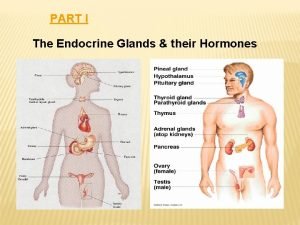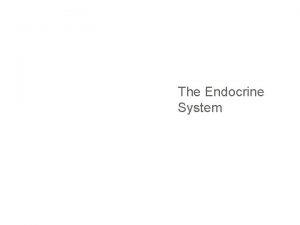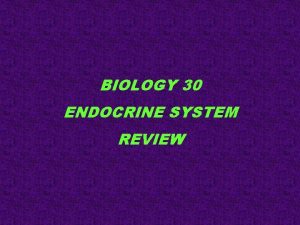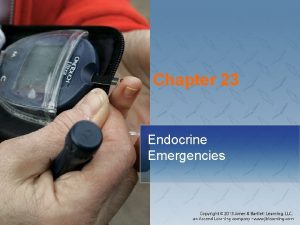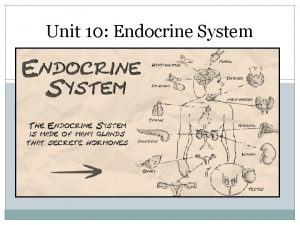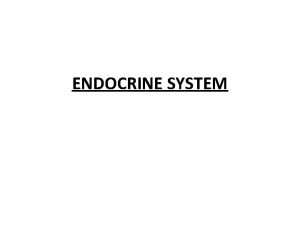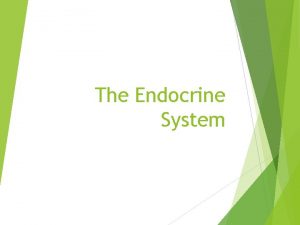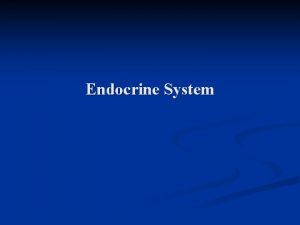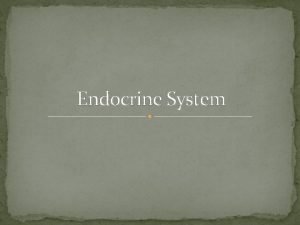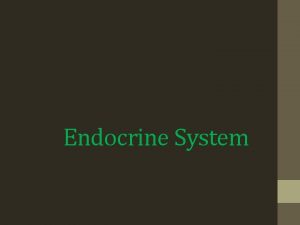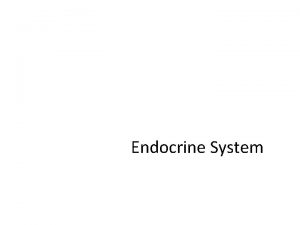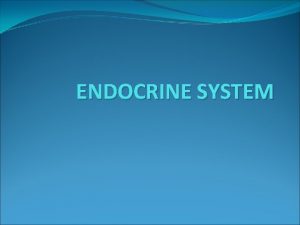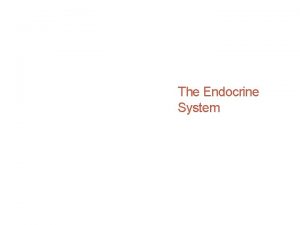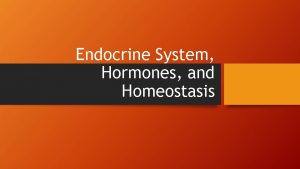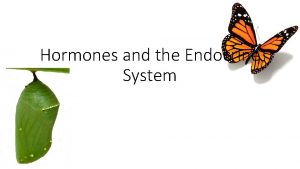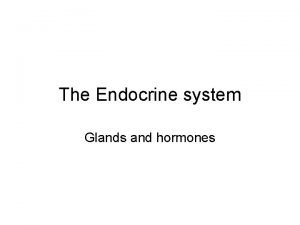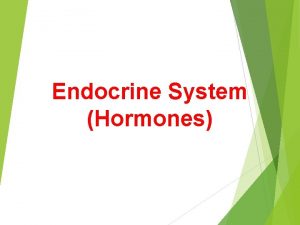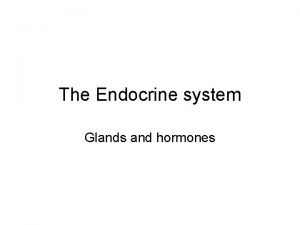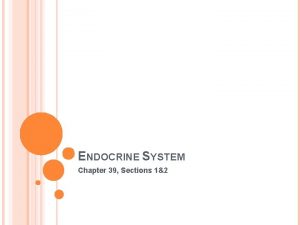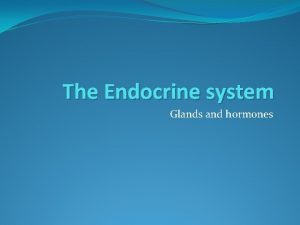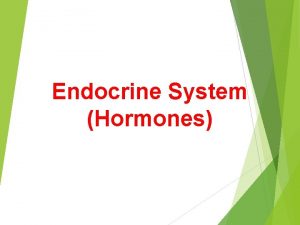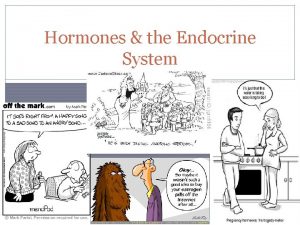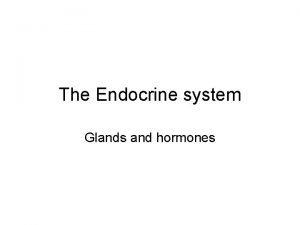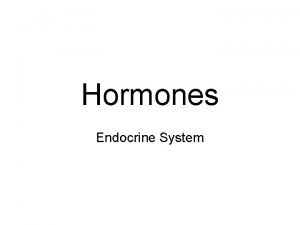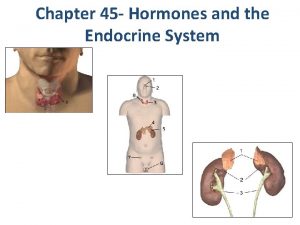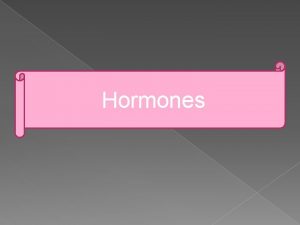The Endocrine System Hormones What is the Endocrine
























- Slides: 24

The Endocrine System Hormones!!!

What is the Endocrine System ? THE ENDOCRINE SYSTEM IS A WIDESPREAD OF GLANDS THROUGHOUT THE BODY THAT PRODUCE HORMONES OR “MESSENGER MOLECULES” THAT REGULATE THE BODY’S GROWTH, METABOLISM, AND SEXUAL DEVELOPMENT AND FUNCTION. THE HORMONES ARE NOW RELEASED INTO THE BLOODSTREAM AND CARRIED OUT TO TISSUES AND ORGANS THROUGHOUT THE BODY. THE ENDOCRINE SYSTEM WORKS CLOSELY WITH THE NERVOUS SYSTEM, BUT THE SYSTEM WORKS SLOW WHILE THE NERVOUS SYSTEM WORKS FAST

Endocrine Organs Pituitary Glands Thyroid Gland Adrenal Gland Pancreas Ovary ( female) Testes ( Male)

Hormones & Glands The endocrine system is founded on hormones and glands. Hormones transfer info and orders from a set of cells to another.

A gland is a bunch of cells that produce and gives off chemicals. A gland ‘selects and removes materials from the blood, processes them, and secretes the finished chemical product for use somewhere in the body. ’ For example, exocrine glands like the sweat glands release secretions in the skin or inside the mouth.

These are the main parts of the endocrine system…

Endocrine System Parts Hypothalamus Pituitary Gland Thyroid Parathyroids Adrenal Glands Pineal Body Reproductive Glands

Hypothalamus In the lower central part of the brain The main link between the endocrine and the nervous systems. Nerve cells in the hypothalamus control the pituitary gland by producing chemicals that either stimulate or suppress hormone secretions from the pituitary.

Pituitary Gland The gland is no bigger than a pea. Located at the base of the brain, and the most important part of the entire endocrine system. AKA: The master gland because it makes hormones that control other endocrine glands. The production of hormones and secretions can be affected by emotions and seasons change. Divided into two parts.

Pituitary Glands Often called the “master” glands of the endocrine system, it is the major gland in the endocrine system. It’s secretes at least six different hormones that affect growth, sexual development, metabolism, and the system of reproduction. The two most important are the Thyroid stimulating hormone & Adrenocorticotropic Hormone Thyroid stimulating hormone which causes the Thyroid to release its hormones. it also secretes Adrenocorticotropic Hormone which causes the adrenal glands function.

The Division The tiny pituitary has two parts: the anterior and the posterior lobe. The anterior regulates the thyroid, adrenals, and the reproductive’s activities. It makes hormones like growth hormones, prolactin (breastfeeding), thyrotropin, and corticotropin. The posterior releases antiduretic hormones, which balances the body’s water level. It also makes oxytocin, which activates the contractions of the uterus in a woman in labor. The pituitary also secretes endorphins, chemicals that act on the nervous sytem and reduce painful feelings. It also gets rid of hormones that signal the reproductive organs to make sex hormones. It also controls ovulation and the menstrual cycle.

The thyroid is in the front part of the lower neck, and is shaped like a butterfly. It produces the hormones known as thyroxine and triiodothyronine. These control the rate at which cells burn fuels from food to produce energy. Thyroid hormones are important because they participate in the growth and development of kids’ and teens’ bones and the nervous system. Attached to the thryoid are four small glands called the parathyroids, which, with the help of calcitonin, control the calcium level.

Thyroid Gland A large ductless gland in the neck that secretes hormones regulating growth and development through the rate of metabolism. Also known as the “activity gland”, it produces two main hormones, thyroxine (T 4) and Triiodothyronine (T 3), these hormones are needed to keep the body functioning at a normal rate. If the thyroid gland DOESN’T PRODUCE ENOUGH hormones you will feel tired and lethargic (sluggish) and put on weight easily. This is called hypothyroidism, or myxedema. If the thyroid gland PRODUCES TOO MUCH hormone you will lose weight, have an increased appetite, feel shaky and anxious, or have palpitations. This is known as hyperthyroidism, or thyrotoxicosis.

There are two adrenal glands, one on top of each kidney. There are two parts, each of which makes hormones and has a different function. The outer part, or the Arenal Cortex, makes hormones (corticosteroids) that control the salt and water balance in the body, responses to stress, metabolism, the immune system, and sexual development/function. The inner part, or the Adrenal Medulla, makes hormones (catecholamines) that increases blood pressure and heart rate when there is stress. (ex. Epinephrine, or adrenaline) Adrenal Glands

Adrenal Glands Also known as the “suprarenal” glands. They are small triangular shaped glands located on top of both kidneys. “Suprarenal” means on top of the kidney. Adrenal Cortex (outer) secretes corticosteriods Adrenal Medulla (inner) secretes catecholamines that increases blood pressures and heart rate when stressed out Adrenal Glands secrete lipid based steroid hormones.

Pancreas The pancreas is an oblong flattened gland located deep in the abdomen. This gland is an integral part of the digestive system that often goes unnoticed until problems occur. Insulin is the most important thing that the Pancreas secretes If too much is secreted If not enough is secreted you may have diabetes

The pineal gland, or the pineal body is in the middle of the brain. It secretes melatonin, a hormone that regulates when you sleep at night and wake up in the morning.

Reproductive Glands!!! The gonads are the main source of sex hormones. Even though you may think that gonads are just in guys, you’re wrong! Girls have them too…

The Gonads (Testes and Ovaries) The testes is an organ whose main function is to produce sperms. The ovaries main function is to produce eggs and hormones so that when fertilized the woman can become pregnant

Male Gonads In guys the male gonads, or testes are located in the scrotum. They secrete hormones called androgens, the most important of which is testosterone. These hormones tell a guy's body when it's time to make the changes associated with puberty, like penis and height growth, deepening voice, and growth in facial and pubic hair. Working with hormones from the pituitary gland, testosterone also tells a guy's body when it's time to produce sperm in the testes.

The ovaries are located in her pelvis. They produce eggs and secrete the female hormones estrogen and progesterone. Estrogen is involved when a girl begins to go through puberty. During puberty, a girl will experience breast growth, will begin to accumulate body fat around the hips and thighs, and will have a growth spurt. Estrogen and progesterone are also involved in the regulation of a girl's menstrual cycle. These hormones also play a role in pregnancy. Female Gonads

What Does the Endocrine System Do? Once a hormone is secreted, it travels from the endocrine gland that produced it through the bloodstream to the cells designed to receive its message. These cells are called target cells. Along the way to the target cells, special proteins bind to some of the hormones. These proteins act as carriers that control the amount of hormone that is available for the cells to use. The target cells have receptors that latch onto only specific hormones, and each hormone has its own receptor, so that each hormone will communicate only with specific target cells that have receptors for that hormone. When the hormone reaches its target cell, it locks onto the cell's specific receptors and these hormone-receptor combinations transmit chemical instructions to the inner workings of the cell. When hormone levels reach a certain normal amount, the endocrine system helps the body to keep that level of hormone in the blood. For example, if the thyroid gland has secreted the right amount of thyroid hormones into the blood, the pituitary gland senses the normal levels of thyroid hormone in the bloodstream. Then the pituitary gland adjusts its release of thyrotropin, the hormone that stimulates the thyroid gland to produce thyroid hormones. Another example of this process is parathyroid hormone. Parathyroid hormone increases the level of calcium in the blood. When the blood calcium level rises, the parathyroid glands sense the change and reduce their secretion of parathyroid hormone. This turnoff process is called a negative feedback system.

http: //www. reference. com/motif/health/what- hormones-does-the-pituitary-gland-secrete http: //www. innerbody. com/image/endo 01. html http: //www. healthline. com/human-bodymaps/thyroid-gland http: //pathology. jhu. edu/pc/Basic. Overview 1. php? a rea=ba

http: //www. ama-assn. org//ama/pub/physician- resources/patient-education-materials/atlas-ofhuman-body/endocrine-system. page http: //martinfrost. ws/htmlfiles/dec 2006/thyroid. ht ml http: //www. nlm. nih. gov/medlineplus/adrenalgland disorders. html ( adrenal gland disorders)
 A hormone
A hormone Hormones
Hormones Endocrine system and reproductive system
Endocrine system and reproductive system Endocrine system and nervous system
Endocrine system and nervous system Lympathic
Lympathic Mechanism of action of hormones
Mechanism of action of hormones Adh function
Adh function Chapter 16 matching questions 6-10
Chapter 16 matching questions 6-10 Adenohypophysis
Adenohypophysis The body's speedy electrochemical communication network
The body's speedy electrochemical communication network Comparison of endocrine and nervous system
Comparison of endocrine and nervous system Steroids endocrine system
Steroids endocrine system Facts about the endocrine system
Facts about the endocrine system External anatomy of rat
External anatomy of rat Humoral neural and hormonal stimuli
Humoral neural and hormonal stimuli Exocrine glands are ductless
Exocrine glands are ductless Chapter 7 13 endocrine system
Chapter 7 13 endocrine system Mammillary body
Mammillary body Figure of endocrine system
Figure of endocrine system Hypothal
Hypothal Biology 30 endocrine system
Biology 30 endocrine system Gonads glands
Gonads glands Pituitary
Pituitary Endocrine system analogy
Endocrine system analogy Introduction of endocrine system
Introduction of endocrine system








